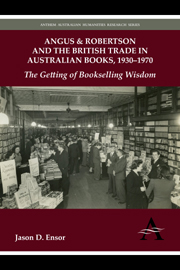 Angus & Robertson and the British Trade in Australian Books, 1930–1970
Angus & Robertson and the British Trade in Australian Books, 1930–1970 Book contents
- Frontmatter
- Contents
- Dramatis Personae
- Preface
- Acknowledgements
- Chapter 1 The Company that Loved Australian Books
- Chapter 2 The Overseas Books in Australian Publishing History
- Chapter 3 Triangles of Publishing and Other Stories
- Chapter 4 The World is Made of Paper Restrictions
- Chapter 5 The First Salesman in London
- Chapter 6 The Getting of Bookselling Wisdom
- Chapter 7 Preparing for ‘Operation London’
- Chapter 8 The Shiralee in the North
- Chapter 9 A Commercial and Cultural Relationship
- Chapter 10 Tomorrow, When London Publishing Ended
- Chapter 11 A House is Rebuilt
- Chapter 12 The Hidden Parts of Publishing Fortune
- Chapter 13 Learning from a Distance
- Figures and Tables
- Notes
- Bibliography
- Index
Chapter 9 - A Commercial and Cultural Relationship
Published online by Cambridge University Press: 05 July 2013
- Frontmatter
- Contents
- Dramatis Personae
- Preface
- Acknowledgements
- Chapter 1 The Company that Loved Australian Books
- Chapter 2 The Overseas Books in Australian Publishing History
- Chapter 3 Triangles of Publishing and Other Stories
- Chapter 4 The World is Made of Paper Restrictions
- Chapter 5 The First Salesman in London
- Chapter 6 The Getting of Bookselling Wisdom
- Chapter 7 Preparing for ‘Operation London’
- Chapter 8 The Shiralee in the North
- Chapter 9 A Commercial and Cultural Relationship
- Chapter 10 Tomorrow, When London Publishing Ended
- Chapter 11 A House is Rebuilt
- Chapter 12 The Hidden Parts of Publishing Fortune
- Chapter 13 Learning from a Distance
- Figures and Tables
- Notes
- Bibliography
- Index
Summary
As discussed in previous chapters, there was a two-fold rationale for Angus & Robertson to setup a London office. One goal was to secure British and American titles; the other was to sell Australian books in the United Kingdom. Bearing in mind that London was the centre of a massive English-language book trade that included Australia, Ferguson was concerned that authors would leave Angus & Robertson unless it offered a ‘reasonable chance of distribution in the big overseas English-speaking markets’. When new Angus & Robertson managing director Walter Burns announced in 1960 that ‘publishing in London was finished’, not surprisingly this galvanised opposition to his ‘Napoleonic’ management and merchandising principles (discussed further in the next chapter). Just a year earlier, Angus & Robertson's Sydney office had resigned from the Australian Booksellers Association over an attempted resolution that ‘no bookseller who was also a publisher could hold any executive office in the A.B.A.’ Given that Angus & Robertson doubled as publishers and booksellers and had staff on the committee, Ferguson dismissed the Australian Booksellers Association in the belief that it would lose most of its ‘bargaining power’ with British publishers following his company's resignation.
- Type
- Chapter
- Information
- Angus & Robertson and the British Trade in Australian Books, 1930–1970The Getting of Bookselling Wisdom, pp. 101 - 110Publisher: Anthem PressPrint publication year: 2012


